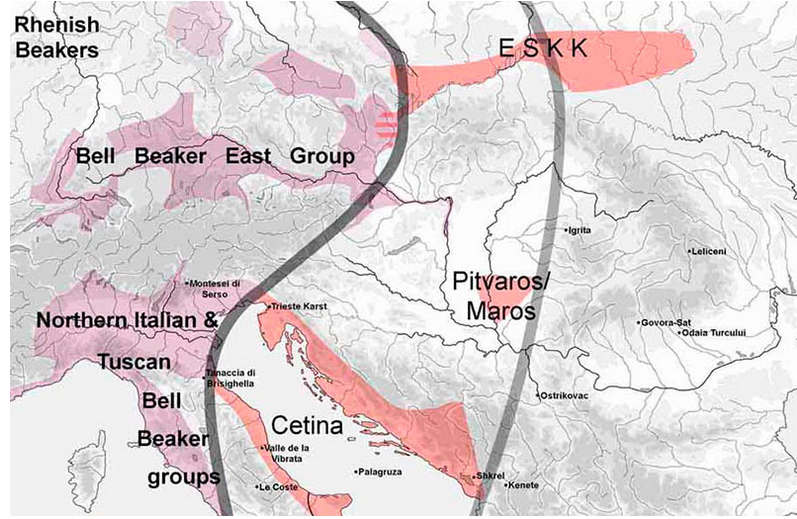PaleoRevenge
Regular Member
- Messages
- 955
- Reaction score
- 672
- Points
- 93
Riverman, today I had the idea of creating Neolithic averages by countries, I checked the individuals for IE mixture, and only kept neolithic profiles that lacked IE mixture. I ignored WHG because that is irrelevant, that is the characteristic that sets them apart regionally.
Very interesting patterns, but also I'd like to hear your opinion on what I call the Dardani cluster, because if this reads are correct, they once lived in north-western Hungary.
Two versions:

With ROU_N_outlier1:I7126

Personally I don't like excluding ROU_N_outlier1:I7126, because the Romanian Neolithic sample is small, and Romania is a big country, the outlier has about 20% WHG, which is not atypical in neighboring regions like Serbia.
Anyhow, here is some interesting patterns:
1) Himera's E-V13s are clearly not Illyrians. Their neolithic component is based in Romania or/and Hungary. I10946 association with Hungary makes sense, you would recall that was my original appraisal on it's location. In this chart I10950 looks Dacian, just as it did using IA proxies.
2) The Dardanian cluster (MJ12, I18832, I10379 and the partial Dardanis) is a surprise. This calc supports a northern origin to R1b-Z2103 (neolithic component preferred is Czech). I am clueless on the archeological knowledge and context here. Is there anything that supports such a scenario? A Yamnaya branch in western Hungary getting progressively pushed down by Corded derived groups until it ends up in the southern Balkans (Brnica and Babadag culture)? I kind of brushed aside the fact that Paeonia resembles the name Pannonia. There might a chronological connection behind the name.
3) Thracian has a strong Romanian neolithic.
4) Illyrians pick up Italian neolithic, supporting you and Torzio claims (they were getting genetic feedback from Italian Beakers and later Italics and Celts).
I probably should have spent an additional 30 minutes and added Alpine and German Neolithic averages, so eastern Celtic groups could be tested out too, but I am Balkan centric in my approaches.
Very interesting patterns, but also I'd like to hear your opinion on what I call the Dardani cluster, because if this reads are correct, they once lived in north-western Hungary.
Two versions:

With ROU_N_outlier1:I7126

Personally I don't like excluding ROU_N_outlier1:I7126, because the Romanian Neolithic sample is small, and Romania is a big country, the outlier has about 20% WHG, which is not atypical in neighboring regions like Serbia.
Anyhow, here is some interesting patterns:
1) Himera's E-V13s are clearly not Illyrians. Their neolithic component is based in Romania or/and Hungary. I10946 association with Hungary makes sense, you would recall that was my original appraisal on it's location. In this chart I10950 looks Dacian, just as it did using IA proxies.
2) The Dardanian cluster (MJ12, I18832, I10379 and the partial Dardanis) is a surprise. This calc supports a northern origin to R1b-Z2103 (neolithic component preferred is Czech). I am clueless on the archeological knowledge and context here. Is there anything that supports such a scenario? A Yamnaya branch in western Hungary getting progressively pushed down by Corded derived groups until it ends up in the southern Balkans (Brnica and Babadag culture)? I kind of brushed aside the fact that Paeonia resembles the name Pannonia. There might a chronological connection behind the name.
3) Thracian has a strong Romanian neolithic.
4) Illyrians pick up Italian neolithic, supporting you and Torzio claims (they were getting genetic feedback from Italian Beakers and later Italics and Celts).
I probably should have spent an additional 30 minutes and added Alpine and German Neolithic averages, so eastern Celtic groups could be tested out too, but I am Balkan centric in my approaches.
Code:
BGR_N:Avg,0.1211077,0.1806626,0.0114268,-0.0889219,0.0541641,-0.045515,-0.000188,-0.0028151,0.0397187,0.0845575,0.0116594,0.0139526,-0.022864,-0.0011148,-0.0366987,-0.0141739,0.0211353,0.0055363,0.0081705,-0.0132563,-0.0116794,0.0063558,-0.0049793,-0.0041089,-0.0098674
BGR_Krepost_N:I0679_d,0.1161,0.152329,-0.024513,-0.071383,0.020311,-0.042112,-0.003525,-0.012461,0.005113,0.047746,-0.006333,0.009292,-0.014866,-0.013625,-0.029451,-0.014187,0.019297,0.002027,0.006536,-0.00963,-0.012977,-0.001113,-0.006162,0.000964,-0.001676
CZE_EE:Avg,0.127237964285714,0.17097175,0.0509921071428571,-0.0404442142857143,0.0819822142857143,-0.0237257142857143,-0.000654642857142857,0.00443392857142857,0.0550607857142857,0.0779645357142857,0.000144928571428572,0.0109027857142857,-0.022315,-0.00614885714285714,-0.0161603214285714,0.000895,0.0154737142857143,0.004122,0.00753732142857143,-0.00224225,0.00953217857142857,0.006483,-0.01290575,-0.0280934285714286,0.000440464285714286
CZE_EN_LBK:I15818,0.124067,0.18178,0.005657,-0.091086,0.056934,-0.044901,-0.009165,-0.004154,0.038655,0.08146,0.005196,0.018284,-0.030178,-0.007156,-0.039902,-0.001458,0.034161,-0.002534,0.01345,-0.004752,-0.014599,0.011376,-0.008011,0.006266,0.000958
CZE_ME:Avg,0.124392285714286,0.169956214285714,0.0544939285714286,-0.0342841428571429,0.0824109285714286,-0.0206178571428571,0.000419714285714286,0.00456571428571428,0.0517447142857143,0.0746646428571428,0.00145,0.00639064285714286,-0.0203134285714286,-0.00460057142857143,-0.0150649285714286,-0.0001135,0.0111852142857143,0.00594535714285714,0.00472271428571429,-0.00364464285714286,0.00912671428571428,0.00552028571428571,-0.0128618571428571,-0.0287389285714286,0.000350714285714286
CZE_N:Avg,0.125611857142857,0.1793135,0.0332404285714286,-0.0636540714285714,0.0725628571428572,-0.0344431428571429,-0.00334035714285714,0.000164857142857143,0.049933,0.0792597142857143,0.00394357142857143,0.0102338571428571,-0.0220018571428571,0.000186785714285714,-0.0274639285714286,-0.0030685,0.0150593571428571,0.00213557142857143,0.010442,-0.00544014285714286,-0.000641785714285715,0.00774578571428571,-0.0089355,-0.0144768571428571,-0.00251485714285714
GRC_N:Avg,0.119134833333333,0.177548333333333,-0.00691383333333333,-0.0980306666666667,0.043649,-0.043228,-0.00207583333333333,-0.00492283333333333,0.0276108333333333,0.0755976666666667,0.00617066666666667,0.0126888333333333,-0.0233148333333333,-0.00190383333333333,-0.0372553333333333,-0.00791116666666667,0.0221435,0.00109783333333333,0.0093435,-0.0137983333333333,-0.0171988333333333,0.002947,-0.0035125,-0.000361666666666667,-0.00469016666666667
HRV_N:Avg,0.120146555555556,0.181140333333333,0.0140232962962963,-0.0905238518518519,0.0603644814814815,-0.0414411111111111,-0.003203,-0.00304266666666667,0.0446619259259259,0.0861436666666667,0.00674807407407407,0.0135491111111111,-0.0230973703703704,-0.0010142962962963,-0.0379764814814815,-0.0122081111111111,0.0167615185185185,0.000957222222222222,0.0104841481481481,-0.00956937037037037,-0.0106200740740741,0.00504222222222222,-0.00389837037037037,-0.005516,-0.00431981481481481
HUN_N:Avg,0.124784739130435,0.178203304347826,0.0188970434782609,-0.0799004347826087,0.0640452826086957,-0.0407058913043478,-0.00309084782608696,-0.00157517391304348,0.0441993913043478,0.0816893260869565,0.00725458695652174,0.0111063913043478,-0.0200174782608696,0.00247717391304348,-0.0374912391304348,-0.011832152173913,0.0149771739130435,0.00276236956521739,0.0115942173913044,-0.0110135,-0.00967047826086956,0.00731163043478261,-0.00604180434782609,-0.00889589130434782,-0.0042849347826087
ITA_N:Avg,0.1237256,0.1804595,0.0142173,-0.0789412,0.0601651,-0.0393792,-0.0045356,-0.0041076,0.0448929,0.0854687,0.0034102,0.014537,-0.0250643,-0.0053535,-0.0301435,-0.0051974,0.0187754,0.0022805,0.0079819,-0.0086792,-0.0063386,0.0032891,-0.0049669,-0.0119414,-0.0007425
ITA_Sardinia_N:Avg,0.126217166666667,0.178564,0.0427822777777778,-0.0560763888888889,0.0788693888888889,-0.0303680555555556,-0.00400816666666667,-0.000282,0.0600732222222222,0.0990455,0.00119977777777778,0.0165268888888889,-0.0346132222222222,-0.0150925555555556,-0.0187669444444444,-0.00144377777777778,0.0134731111111111,0.00211144444444444,0.00486027777777778,-0.0112137222222222,0.00167055555555556,0.00280272222222222,-0.0120851111111111,-0.0285113333333333,0.00118427777777778
ITA_Sicily_MN:Avg,0.1186605,0.17555975,0.0204115,-0.07275575,0.065704375,-0.0393935,-0.0073145,-0.00432675,0.04542975,0.0848535,0.00379575,0.00962875,-0.020459375,-0.004042625,-0.031538,-0.0044085,0.01962275,0.003484,0.008484625,-0.0115525,-0.00430475,0.006677375,-0.00756425,-0.01322475,-0.003802
MKD_N:I0676,0.122929,0.182795,-0.000754,-0.103037,0.063704,-0.046296,-0.00376,-0.001385,0.046222,0.090571,0.01153,0.014837,-0.031516,0.003303,-0.042073,-0.011535,0.024251,0.005448,0.013701,-0.012006,-0.016346,0.011623,0.001109,0.00494,-0.007664
ROU_N:Avg,0.1246365,0.18406475,0.0118795,-0.0973845,0.061396,-0.04894525,-0.00475875,-0.0047305,0.04637575,0.092075,0.006861,0.01442475,-0.0239715,0.0036815,-0.0477395,-0.01431975,0.019199,0.008203,0.01461225,-0.00912925,-0.01553525,0.006059,-0.00714825,0.0038255,-0.00874175
SRB_N:Avg,0.129378666666667,0.183134,0.011188,-0.097869,0.0588826666666667,-0.0449943333333333,-0.00156666666666667,-0.00707666666666667,0.0407686666666667,0.0896603333333333,0.00319366666666667,0.015586,-0.0223486666666667,4.60000000000003E-05,-0.0417566666666667,-0.015513,0.0200356666666667,0.000253666666666667,0.0111033333333333,-0.0124643333333333,-0.00540733333333333,0.004328,-0.00772366666666667,0.00453866666666667,0.000279333333333333
POL_BKG_N:Avg,0.121600833333333,0.171793666666667,0.0336266666666667,-0.0614238333333333,0.0693461666666667,-0.0323976666666667,0.000391666666666667,-0.000230833333333333,0.0459496666666667,0.0785738333333333,0.0023545,0.009391,-0.0177153333333333,0.00309666666666667,-0.0301073333333333,-0.00556883333333333,0.0116476666666667,0.00287166666666667,0.0128631666666667,-0.0093795,-0.0042425,0.00748116666666667,-0.00796983333333333,-0.0190388333333333,-0.00347283333333333
POL_Globular_Amphora:Avg,0.128294857142857,0.170101357142857,0.0588578571428571,-0.0259092142857143,0.0830045,-0.0214147857142857,0.00129257142857143,0.00702164285714286,0.0525772142857143,0.0728814285714286,0.000464,0.0100946428571429,-0.0171702142857143,-0.0066255,-0.0132132142857143,0.000606142857142857,0.00724564285714286,0.00614428571428571,0.00683264285714286,-5.35714285714284E-05,0.00962578571428572,0.00711878571428571,-0.0137949285714286,-0.0258728571428571,0.000213928571428572
WHG:SRB_Iron_Gates_Avg,0.13046975,0.11805525,0.1794505,0.174532,0.1301396875,0.05351209375,0.01399796875,0.0320540625,0.06475096875,-0.00843409375,-0.00892628125,-0.0168138125,0.02473340625,-4.21874999999999E-06,0.032080875,0.04726409375,0.00466528125,0.0055781875,-0.006768,0.04741340625,0.07336275,0.01101284375,-0.03336925,-0.12037075,0.01111040625
WHG:ITA_Villabruna,0.121791,0.114755,0.18592,0.184111,0.156337,0.060798,0.020211,0.035998,0.092445,0.018041,-0.016239,-0.016186,0.016947,-0.010046,0.054017,0.067356,0.000782,0.005448,-0.008422,0.053526,0.100073,0.010758,-0.048313,-0.163517,0.01928
GEO_CHG,0.091058,0.102568,-0.083344,-0.00323,-0.08617,0.020638,0.024911,-0.001846,-0.128236,-0.074717,-0.006333,0.023979,-0.054856,0.004404,0.026601,-0.03275,0.02386,-0.013429,-0.022249,0.034767,0.033815,-0.007048,0.006532,-0.025787,-0.002036
IRN_TepeHissar_C:Avg,0.0780204545454546,0.0983218181818182,-0.120918545454545,-0.0128612727272727,-0.0963815454545454,0.0127782727272727,0.0129470909090909,-0.00505581818181818,-0.0701888181818182,-0.0367123636363636,-0.00394154545454545,-0.00129436363636364,-0.00114881818181818,-0.00295263636363636,0.0196547272727273,0.0289646363636364,-0.00679172727272727,0.00532090909090909,0.00764481818181818,-0.0237274545454545,0.00626190909090909,-0.0142986363636364,-0.00521,-0.0225331818181818,0.0140867272727273
Yamnaya_Avg:,0.120715777777778,0.0878996666666667,0.0439556111111111,0.113661111111111,-0.0293728888888889,0.0448704444444444,0.00420394444444444,-0.00333322222222222,-0.0553464444444444,-0.0740585555555556,0.000496055555555556,0.000366388888888889,-0.00175922222222222,-0.0232582222222222,0.0337866666666667,0.0136272222222222,-0.000992444444444444,-0.00304055555555556,-0.00233938888888889,0.0107411666666667,-0.00358394444444444,0.000583888888888889,0.0101952777777778,0.0198688333333333,-0.0037055
Corded_Ware_Early(POL_CZE_BALTIC_GER),0.1253507,0.10915866,0.056808809,0.089148191,0.0044132128,0.033087128,0.0037300426,0.00056465957,-0.028402702,-0.041441191,-0.0014857447,0.00009887234,-0.0056111064,-0.014620191,0.026595404,0.0083559362,-0.0093626809,0.0014421702,-0.0005696383,0.0058938085,0.0016965106,0.0034095532,0.0045051064,0.015449404,-0.0021528511
TUR_SE_Mardin_PPN:I8432,0.071709,0.131003,-0.084098,-0.097223,-0.052625,-0.032909,-0.009165,-0.011307,-0.020861,-0.009841,0.026469,-0.007044,0.009812,0.014175,-0.005836,0.000663,-0.002217,0.006081,-0.000377,0.002876,-0.000749,0.012984,-0.001849,-0.023618,0.008861
Levant_PPNB,0.0725625,0.1650235,-0.0309238,-0.1380835,0.0323138,-0.062541,-0.012103,-0.0141338,0.0735775,0.0367207,0.0194055,-0.0170098,0.036459,-0.000241,-0.021342,0.0067288,0.0089638,-0.0013935,-0.0054052,0.0192277,-0.0037435,0.007852,-0.0014175,-0.0062658,-0.0047002
Uralic(RUS_HG),0.10471733,-0.068040567,0.095076233,0.1915759,-0.082477,0.043630767,-0.0425109,-0.048331333,-0.032042,-0.088526,0.022084667,-0.0095581,0.026246767,-0.071105233,0.024595433,0.017958433,-0.012908,-0.0047716667,-0.00019543333,0.0012226667,-0.031680433,0.013217333,0.023992333,0.0063325667,-0.0095001


